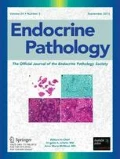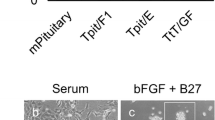Abstract
Human pituitary cells proliferate very slowly in vitro. Only a few cell lines have been established, and these have been used mainly for short-term studies. To obtain immortalized cell lines of human pituitary adenomas for in vitro studies, we infected adenoma cells with a replication-defective recombinant human adenovirus, which contains an SV40 early large T-antigen. One of the cell lines (HP75), which has been studied in culture during 60 passages, has been extensively characterized. It expressed the large T-antigen protein and its mRNA, as well as the genes for FSH-β, LH-β and α-subunit (α-SU) of gonadotropin hormone.
The HP75 cell line also expressed the genes of various members of the chromogranin (Cg)/secretogranin (Sg) family, including CgA as well as the prohormone convertases PC1/3 and PC2. CgA was processed to pancreastatin in vitro, which was secreted into the culture medium. Treatment with phorbol 12-myristate 13-acetate (PMA), TGF-β1, and forskolin increased CgA expression in the cells and stimulated pancreastatin secretion into the medium while inhibiting cell growth. The HP75 cell line also expressed TGF-β mRNA isoforms (β1, β2, β3) and the mRNAs for the receptors for TGF-β (RI, RII, and RIII). The cells responded to TGF-β1 in vitro by increasing CgA protein expression and pancreastatin secretion. TGF-β-RII protein and mRNA expression were both increased by PMA.
Ultrastructural studies showed that the HP75 cells had very few dense-core secretory granules and a poorly developed Golgi complex. After treatment with TGF-β1 and PMA, there was an increase in the development of rough endoplasmic reticulum and the Golgi complex.
This is the first report of the development of an immortalized human pituitary cell line that retains some differentiated functions. HP75 can be used to study TGF-β and CgA functions in pituitary cells. Replication-defective recombinant human adenovirus with an SV40 large T-antigen insert can be used to generate other immortalized human pituitary cell lines for in vitro studies.
Similar content being viewed by others
References
Kohler PO, Bridson WE, Rayford PL, Kohler SE. Hormone production by human pituitary adenomas in culture. Metab Clin Exp 18:782–788, 1969.
O'Sullivan JP, Alexander KM, Jenkins JS. Maintenance of functioning human pituitary tumors in nude athymic mice. J Endocrinol 79:139–140, 1978.
Synder J, Hymer WC, Wilfinger WW. Culture of human pituitary prolactin and growth hormone cells. Cell Tissue Res 191:379–388, 1978.
Adams EF, Brajkovich IE, Mashiter K. Hormone secretion by dispersed cell cultures of human pituitary adenomas: effects of theophylline, thyrotropin-releasing hormone, somatostatin, and 2-bromo-alpha-ergocryptine. J Clin Endocrinol Metab 49:120–126, 1979.
Lipson LG, Beitins IZ, Komblith PL, McArthur JW, Friesen HG, Kliman B, et al. Tissue culture studies on human pituitary tumours: long term release of anterior pituitary hormones into the culture medium. Acta Endocrinol 90:421–433, 1979.
Wyche JH, Noteboom WD. Production of a growth factor in cultured human pituitary cells [Abstract]. J Cell Biol 75:81, 1977.
Wyche JH, Noteboom WD. Growth regulation of cultured human pituitary cells by steroidal and nonsteroidal compounds in defined medium. Endocrinology 104:1765–1773, 1979.
See YP, Sun AM, McComb DJ, Gerrie B, Kovacs K. Ultrastructural differentiation in the nude mouse of transformed cells isolated from the human fetal pituitary gland. Cancer Res 42:2336–2343, 1982.
Kikuchi Y, Seki K, Momose E, Kizawa I, Oomori K, Shima K, et al., Establishment and characterization of a new human cultured cell line from a prolactin-secreting pituitary adenoma. Cancer Res 45:5722–5727, 1985.
Woodworth CD, Kreider JW, Mengel L, Miller T, Meng YL, Isom HC. Tumorigenicity of simian virus 40-hepatocyte cell lines. Effect of in vitro and in vivo passage on expression of liver-specific genes and oncogenes. Mol Cell Biol 8:4492–4501, 1988.
Van Doren K, Gluzman Y. Efficient transformation of human fibroblast by adenovirussimian virus 40 recombinants. Mol Cell Biol 4:1653–1656, 1984.
Sen A, Dunnmon P, Henderson SA, Gerard RD, Chien KR. Terminally differentiated neonatal rat myocardial cells proliferate and maintain specific differentiated functions following expression of SV40 large T antigen. J Biol Chem 263:19,132–19,136, 1988.
Nakamigawa T, Momoi MY, Momoi T, Yanagisawa M. Generation of human myogenic cell lines by the transformation of primary culture with origin-defective SV40 DNA. J Neurol Sci 83:305–319, 1988.
Wyllie FS, Bond JA, Dawson T, White D, Davies R, Wynford-Thomas D. A phenotypically and karyotypically stable human thyroid epithelial line conditionally immortalized by SV40 large T antigen. Cancer Res 52:2938–2945, 1992.
Chou JY. Differentiated mammalian cell lines immortalized by temperature-sensitive tumor virus. Mol Endocrinol 3:1511–1514, 1989.
Lei K-J, gluzman Y, Pan C-J, Chou JY. Immortalization of virus-free human placental cells that express tissue-specific functions. Mol Endocrinol 6:703–712, 1992.
Bernard R, Le Bert M, Borde I, Galiana E, Evrard C, Rouget P. Immortalization of different precursors of glial cells with a targeted and temperature-sensitive oncogene. Exp Cell Res 214:373–380, 1994.
Chou JY. Establishment of rat fetal liver lines and characterization of their metabolic and hormonal properties. Use of temperature-sensitive SV40 virus. Methods Enzymol 109: 385–396, 1985.
Hurst BS, Zilberstein M, Chou J-Y, Litman B, Stephens J, Leslie KK. Estrogen receptors are present in human granulosa cells. J Clin Endocrinol Metab 80:229–232, 1995.
Windle JJ, Weiner RI, Mellon PL. Cell lines of the pituitary gonadotype lineage derived by targeted oncogenesis in transgenic mice. Mol Endocrinol 4:597–603, 1990.
Alarid ET, Windle JJ, Whyte DB, Mellon PL. Immortalization of pituitary cells at discrete stages of development by directed oncogenesis in transgenic mice. Development 122: 3319–3329, 1996.
Jin L, Scheithauer BW, Young WF Jr, Davis DH, Klee GG, Lloyd RV. Pancreastatin secretion by pituitary adenoma and regulation of chromogranin B mRNA expression. Am J Pathol 148:2057–2066, 1996.
Jin L, Qian X, Kulig E, Sanno N, Scheithauer BW, Kovacs K, et al. Transtorming growth factor-β, transforming growth factor-β receptor II and p27kip1 expression in nontumorous and neoplastic human pituitaries. Am J Pathol 151:509–519, 1997.
Miller GM, Alexander JM, Klibanski A. Gonadotropin-releasing hormone messenger RNA expression in gonadotropin tumors and normal human pituitary. J Clin Endocrinol Metab 81:80–83, 1996.
Sanno N, Jin L, Qian X, Osamura RY, Scheithauer BW, Kovacs K, et al. Gonadotropin-releasing hormone and gonadotropin-releasing hormone receptor messenger ribonucleic acids expression in nontumorous and neoplastic pituitaries. J Clin Endocrinol Metab 82:1974–1982, 1997.
Alexander JM, Klibanski A. Gonadotropinreleasing hormone receptor mRNA expression by human pituitary tumors in vitro. J Clin Invest 93:2332–2339, 1994.
Lloyd RV, Cano M, Landefeld TD. The effects of estrogens on tumor growth and on prolactin and growth hormone mRNA expression in rat pituitary tissues. Am J Pathol 133:397–406, 1988.
Hsu IC, Metcalf RA, Sun T, Welsh JA, Wang NJ, Harris CC. Mutational hot spot in the p53 gene in human hepatocellular carcinomas. Nature 350:427–428, 1991.
Qian X, Jin L, Grande GP, Lloyd RV. Transforming growth factor-β and p27 expression in pituitary cells. Endocrinology 137:3051–3060, 1996.
Morris TJ, Palm SL, Furcht LT, Buchwald H. The effect of levastatin on [3H] thymidine uptake in HTC-4 and LLC-L1 tumor cells. J Surg Res 61:367–372, 1996.
Tashjian AH Jr, Yasumura Y, Levine L, Sato GH, Parker ML. Establishment of clonal strains of rat pituitary tumor cells that secrete growth hormone. Endocrinology 82:342–352, 1968.
Bloomquist BT, Eipper BA, Mains RE. Prohormone-converting enzymes: regulation and evaluation of function using antisense RNA. Mol Endocrinol 5:2014–2024, 1991.
Thiny MT, Antczak C, Fields K, Jin L, Lloyd RV. Effects of estrogen and dexamethasone on a transgenic pituitary cell line. Regulation of hormone and chromogranin/secretogranin expression. Lab Invest 70:899–906, 1994.
Mellon PL, Windle JJ, Weiner RI. Immortalization of neuroendocrine cells by targeted oncogenesis. Rec Prog Horm Res 47:69–96, 1991.
Ozer HL, Slater ML, Dermody JJ, Mandel M. Replication of simian virus 40 DNA in normal human fibroblasts and in fibroblasts from xeroderma pigmentosum. J Virol 39: 481–489, 1981.
Garrel G, McArdle CA, Hemmings BA, Counis R. Gonadotropin-releasing hormone and pituitary adenylate cyclase-activating polypeptide affect levels of cyclic adenosine 3′, 5′-monophosphate-dependent protein kinase A (PKA) subunits in the clonal gonadotrope alpha T3-1 cells: evidence for cross-talk between PKA and protein kinase C pathways. Endocrinology 138:2259–2266, 1997.
Oren M, Maltzman W, Levine AJ. Post-translational regulation of the 54K cellular tumor antigen in normal and transformal cells. Mol Cell Biol 1:101–110, 1981.
Mietz JA, Unger T, Huibregtse JM, Howley PM. The transcriptional transactivation function of wild type p53 is inhibited by SV40 large T-antigen and by HPV-16 E6 oncoprotein. EMBOJ 11:5013–5020, 1992.
Lloyd RV, Wilson BS. Specific endocrine tissue marker defined by a monoclonal antibody. Science 222:628–630, 1983.
Winkler H, Fischer-Colbrie R. The chromogranin A and B: the first 25 years and future perspectives. Neuroscience 49:497–528, 1992.
Huttner WB, Gerdes HH, Rosa P. The granin (chromogranin/secretogranin) family. Trend Biochem Sci 16:27–30, 1991.
Steiner DF, Smeekens SP, Ohagi S, Chan SJ. The new enzymology of precursor processing endoproteases. J Biol Chem 267:23,435–23,438, 1992.
Seidah NG, Chretien M. Pro-protein convertases of subtilisin/kexin family. Methods Enzymol 244:175–188, 1994.
Udupi V, Townsend CM Jr, Gomez G, Zhang T, Greeley GH Jr. Down regulation of prohormone convertase-1 by a phorbol ester. Biochem Biophys Res Commun 217:495–500, 1995.
Wang X-F, Lin HY, Ng-Eaton E, Downward J, Lodish HF, Weinberg RA. Expression cloning and characterization of the TGF-beta type III receptor. Cell 67:797–805, 1991.
Sun L, Wu G, Willson JK, Zborowska E, Yang J, Rajkarunanayake I, et al. Expression of transforming growth factor-beta type II receptor leads to reduced malignancy in human breast cancer MCF-7 cells. J Biol Chem 269:26,449–26,455, 1994.
Markowitz S, Wang J, Myeroff L, Parsons R, Sun L, Lutterbaugh J, et al. Inactivation of the type II TGF-beta receptor in colon cancer cells with microsatellite instability. Science 268:1336–1338, 1995.
Massague J, Polyak K. Mammalian antiproliferative signals and their targets. Curr Opinion Genet Dev 5:91–96, 1995.
Polyak K, Lee MH, Erdjument-Bromage H, Koff A, Roberts JM, Tempst P, et al. Cloning of p27kip1, a cyclin-dependent kinase inhibitor and a potential mediator of extracellular antimitogenic signals. Cell 78:59–66, 1994.
Toyoshima H, Hunter T. p27, a novel inhibitor of G1 cyclin-cdk protein kinase activity, is related to p21. Cell 78:67–74, 1994.
Lloyd RV, Jin L, Qian X, Kulig E. Aberrant p27kip1 expression in endocrine and other tumors. Am J Pathol 150:1–7, 1997.
Castro MG, Goya RG, Sosa YE, Rowe J, Larregina A, Morelli A, et al. Expression of transgenes in normal and neoplastic anterior pituitary cells using recombinant adenovirus: long term expression, cell cycle dependency, and effects on hormone secretion. Endocrinology 138:2184–2194, 1997.
Ham J, Webster J, Bond JA, Jasani B, Lewis MD, Hepburn PJ, Davies JS, Lewis BM, Wynford T, THomas D, Scanlon MF. Immortalized human pituitary cells express glycoprotein α-subunit and thyrotropin B (TSHB). J Clin Endocrinol Metab 83:1598–1603, 1998.
Author information
Authors and Affiliations
Corresponding author
Rights and permissions
About this article
Cite this article
Jin, L., Kulig, E., Qian, X. et al. A human pituitary adenoma cell line proliferates and maintains some differentiated functions following expression of SV40 large T-antigen. Endocr Pathol 9, 169–184 (1998). https://doi.org/10.1007/BF02782609
Issue Date:
DOI: https://doi.org/10.1007/BF02782609




